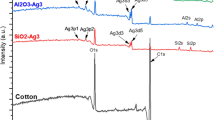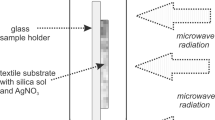Abstract
In the present study, a possibility to realize a transparent sol by zinc-based precursors in a neutral medium without acidic or alkaline catalyst was investigated. Moreover, to study the influence of an inorganic–organic hybrid polymer on the proposed antibacterial finishing, the Zn-based sol was mixed with 3-glycidoxypropyltrimethoxysilane (GPTMS), a hybrid sol–gel precursor, to produce zinc-containing silica coatings on the cotton fibres. An optimization of functionalization process parameters was performed by monitoring survival rate of Escherichia coli bacteria. Finally, selected finishes were tested in respect to their antibacterial activity using potential pathogenic bacteria Staphylococcus aureus and Klebsiella pneumoniae. Sol–gel synthesized cotton finishes based on nano-Zn acetate without and with GPTMS showed larger bactericidal and bacteriostatic activities. The both types of finishes also show hydrophobic effect within the first eliminates the hydrophobicity effect and reduces antibacterial activity. The results are very promising, since the antibacterial activity of cotton is comparably high and the finishing procedure is cheap and can be easily performed.







Similar content being viewed by others
References
Sawai J (2003) Quantitative evaluation of antibacterial activities of metallic oxide powders (ZnO, MgO and CaO) by conductimetric assay. J Microbiol Methods 54:177–182
Tam KH, Djurišić AB, Chan CMN, Xi YY, Tse CW, Leung YH, Chan WK, Leung FCC, Au DWT (2008) Antibacterial activity of ZnO nanorods prepared by a hydrothermal method. Thin Solid Films 516:6167–6174
Zhang L, Ding Y, Povey M, York D (2008) ZnO nanofluids—a potential antibacterial agent. Prog Nat Sci 18:939–944
Yamamoto O (2001) Influence of particle size on the antibacterial activity of zinc oxide. Int J Inorg Mater 3:643–646
Karunakaran C, Rajeswari V, Gomathisankar P (2011) Enhanced photocatalytic and antibacterial activities of sol–gel synthesized ZnO and Ag–ZnO. Mater Sci Semicond Process 14:133–138
Ansari MA, Khan HM, Khan AA, Sultan A, Azam A (2012) Characterization of clinical strains of MSSA, MRSA and MRSE isolated from skin and soft tissue infections and the antibacterial activity of ZnO nanoparticles. World J Microbiol Biotechnol 28:1605–1613
Wang H, Xie C, Zhang W, Cai S, Yang Z, Gui Y (2007) Comparison of dye degradation efficiency using ZnO powders with various size scale. J Hazard Mater 141:645–652
Dastjerdi R, Montazer M (2010) A review on the application of inorganic nano-structured materials in the modification of textiles: focus on anti-microbial properties. Colloids Surf B Biointerfaces 79:5–18
Farouk A, Moussa S, Ulbricht M, Schollmeyer E, Textor T (2013) ZnO-modified hybrid polymers as antibacterial finish for textiles. Text Res J. doi:10.1177/0040517513485623
Spanhel L, Anderson MA (1991) Semiconductor clusters in the sol–gel process: quantized aggregation, gelation and crystal growth on concentrated ZnO colloids. J Am Chem Soc 113:2826–2833
Gao D-G, Chen C, Ma J-Z, Lv B, Jia X-L (2013) Preparation, characterization and application of ZnO sol containing quaternary ammonium salts. J Sol-Gel Sci Technol 65:336–343
Caldara M, Colleoni C, Guido E, Re V, Rosace G (2012) Development of a textile-optoelectronic pH meter based on hybrid xerogel doped with Methyl Red. Sens Actuator B Chem 171–172:1013–1021
Van der Schueren L, De Clerck K, Brancatelli G, Rosace G, Van Damme E, De Vos W (2012) Novel cellulose and polyamide halochromic textile sensors based on the encapsulation of Methyl Red into a sol–gel matrix. Sens Actuator B Chem 162:27–34
Guido E, Colleoni C, De Clerck K, Plutino MR, Rosace G (2014) Influence of catalyst in the synthesis of a cellulose-based sensor: kinetic study of 3-glycidoxypropyltrimethoxysilane epoxy ring opening by Lewis acid. Sens Actuator B Chem 203:213–222
Znaidi L (2010) Sol–gel-deposited ZnO thin films: a review. Mater Sci Eng B 174:18–30
Calvimontes A, Dutschk V, Stamm M (2010) Advances in topographic characterization of textile materials. Text Res J 80:1004–1015
Dutschk V (2013) Surface wetting. From a phenomenon to an important analytical tool. In: Rubio RG, Rjyzantsev YS, Starov VM, Huang G-X, Chetverikov AP, Arena P, Nepomnyashchy AA, Ferrus A, Morozov EG (eds) Without bounds: a scientific canvas of nonlinearity and complex dynamics. Springer, Berlin, pp 227–257
Wenzel RN (1949) Surface roughness and contact angle. J Phys Colloid Chem 53:1466–1467
Mahltig B, Textor T (2008) Nanosols and textiles, 1st edn. World Scientific, London
Calvimontes A, Badrul Hasan MM, Dutschk V (2010) Effects of topographic structure on wettability of differently woven fabrics. In: Dubrovski PD (eds) Woven fabric engineering. Sciyo, Rijeka, Croatia, pp 71–92
Sun T, Hao H, Hao WT, Yi SM, Li XP, Li JR (2014) Preparation and antibacterial properties of titanium-doped ZnO from different zinc salts. Nanoscale Res Lett 98:1–11
Xie Y, He Y, Irwin PL, Jin T, Shi X (2011) Antibacterial activity and mechanism of action of zinc oxide nanoparticles against campylobacter jejuni. Appl Environ Microb 77:2325–2331
Farouk A, Moussa S, Ulbricht M, Schollmeyer E, Textor T (2012) ZnO nanoparticles-chitosan composite as antibacterial finish for textiles. Int J Carbohydr Chem. doi:10.1155/2012/693629
Acknowledgments
This study is related to the activity of the European networks COST MP1106 ‘Smart and Green Interfaces’ and CM1101 ‘Colloidal Aspects of Nanoscience for Innovative Processes and Materials’.
Author information
Authors and Affiliations
Corresponding author
Rights and permissions
About this article
Cite this article
Poli, R., Colleoni, C., Calvimontes, A. et al. Innovative sol–gel route in neutral hydroalcoholic condition to obtain antibacterial cotton finishing by zinc precursor. J Sol-Gel Sci Technol 74, 151–160 (2015). https://doi.org/10.1007/s10971-014-3589-9
Received:
Accepted:
Published:
Issue Date:
DOI: https://doi.org/10.1007/s10971-014-3589-9




